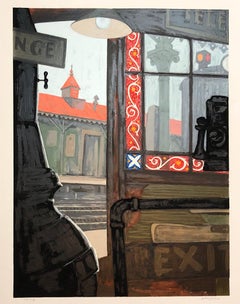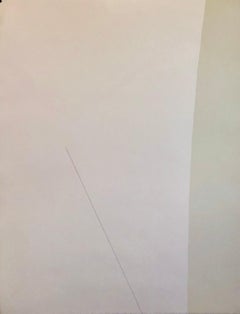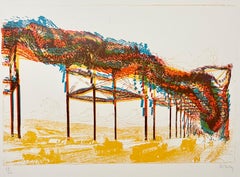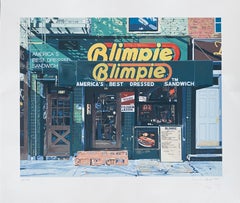Want more images or videos?
Request additional images or videos from the seller
1 of 10
Eliezer WeishoffMixed Media Jerusalem Silkscreen Serigraph Print Mounted to Wood Israeli Judaicac.1970's
c.1970's
Price:$600
About the Item
- Creator:Eliezer Weishoff (1938)
- Creation Year:c.1970's
- Dimensions:Height: 22 in (55.88 cm)Width: 30 in (76.2 cm)
- Medium:
- Movement & Style:
- Period:
- Condition:minor wear commensurate for vintage piece. please see photos.
- Gallery Location:Surfside, FL
- Reference Number:1stDibs: LU3826749612
About the Seller
4.9
Platinum Seller
Premium sellers with a 4.7+ rating and 24-hour response times
Established in 1995
1stDibs seller since 2014
1,810 sales on 1stDibs
Typical response time: 1 hour
Authenticity Guarantee
In the unlikely event there’s an issue with an item’s authenticity, contact us within 1 year for a full refund. DetailsMoney-Back Guarantee
If your item is not as described, is damaged in transit, or does not arrive, contact us within 7 days for a full refund. Details24-Hour Cancellation
You have a 24-hour grace period in which to reconsider your purchase, with no questions asked.Vetted Professional Sellers
Our world-class sellers must adhere to strict standards for service and quality, maintaining the integrity of our listings.Price-Match Guarantee
If you find that a seller listed the same item for a lower price elsewhere, we’ll match it.Trusted Global Delivery
Our best-in-class carrier network provides specialized shipping options worldwide, including custom delivery.You May Also Like
Teal and Red Palm Trees, Landscape Print by Menashe Kadishman
By Menashe Kadishman
Located in Long Island City, NY
Artist: Menashe Kadishman, Israeli (1932 - 2015)
Title: Teal and Red Palm
Year: circa 1979
Medium: Serigraph, signed in pencil
Edition: 125, AP
Image...
Category
1970s Modern Landscape Prints
Materials
Screen
$750
H 40 in W 29.5 in
Fishermen, Modern Screenprints by Millard Owen Sheets
By Millard Sheets
Located in Long Island City, NY
Fisherman by Millard Owen Sheets, American (1907–1989)
Date: circa 1977
Lithograph, signed in pencil
Edition of AP
Image Size: 22 x 29.5 inches
Siz...
Category
1970s American Modern Landscape Prints
Materials
Screen
$1,200
H 27 in W 35 in
Washington Sun - Original Screenprint, Handsigned
By Jacques Monory
Located in Paris, IDF
Jacques Monory
Washington Sun , 1976
Original screen print
Handsigned
On BFK Rives 38 x 28 cm (c. 14x 11 in)
Limited to 300 exemplary, not numbered
INFORMATION: This work is publi...
Category
1970s American Modern Portrait Prints
Materials
Screen
Oil Sentinels, Modern Screenprint by Ginger Osgood
Located in Long Island City, NY
An original hand-signed and numbered screenprint by noted American modern artist, Ginger Osgood (1918 - 2000) depicting Oil Derricks in an abstract lands...
Category
Mid-20th Century American Modern Landscape Prints
Materials
Screen
Jacques Monory - The American Dream , 1976, Original Screenprint
By Jacques Monory
Located in Paris, IDF
Jacques Monory
The American Dream, 1976
Original screen print
Handsigned
On BFK Rives 38 x 28 cm (c. 14x 11 in)
Limited to 300 proofs, not numbered
INFORMATION: This work is publi...
Category
1970s American Modern Portrait Prints
Materials
Screen
$239 Sale Price
33% Off
H 14.97 in W 11.03 in
New York Skyline at Night - Offset Poster, 2008
By Andreas Feininger
Located in Paris, IDF
Andreas FEININGER
New York Skyline at Night, 2008
Offset original vintage poster
On paper 68 x 74 cm (c. 27 x 29 in)
Original poster for artist's exhibition in Fundation Juan March ...
Category
Early 2000s American Modern Landscape Prints
Materials
Screen
West Hill, Modern Screenprint by Peter Kalen
Located in Long Island City, NY
Peter Kalen - West Hill, Year: 1968, Medium: Screenprint on thin wove paper, signed, titled and numbered in pencil, Edition: 2/15, Image Size: 15 x 11 inches, Size: 16.75 x 12 in. (...
Category
1960s Modern Landscape Prints
Materials
Screen
Tree from Nantucket Series (Tan), Modern Screenprint by Bob Cato
Located in Long Island City, NY
Bob Cato, American (1923 - 1999) - Tree from Nantucket Series (Tan), Year: circa 1970, Medium: Screenprint on Somerset, signed and numbered in pencil, Editi...
Category
1970s Modern Landscape Prints
Materials
Screen
$350
H 29.75 in W 22.5 in
Cattails from the Nantucket Series (Tan), Modern Screenprint by Bob Cato
Located in Long Island City, NY
Bob Cato, American (1923 - 1999) - Cattails from the Nantucket Series (Tan), Year: circa 1970, Medium: Screenprint on Somerset, signed and numbered in penci...
Category
1970s Modern Landscape Prints
Materials
Screen
$350
H 29.75 in W 22.5 in
Still Life from the Nantucket Series (Blue), Modern Screenprint by Bob Cato
Located in Long Island City, NY
Bob Cato, American (1923 - 1999) - Still Life from the Nantucket Series (Blue), Year: circa 1970, Medium: Screenprint on Somerset, signed and numbered in pencil, Edition: 56/75, Im...
Category
1970s Modern Landscape Prints
Materials
Screen
$350
H 29.75 in W 22.5 in
More From This Seller
View AllModernist Silkscreen Screenprint 'El Station, Interior' NYC Subway, WPA Artist
By Anthony Velonis
Located in Surfside, FL
screenprint printed in color ink on wove paper. New York City subway station interior.
Anthony Velonis (1911 – 1997) was an American painter and designer born in New York City who helped introduce the public to silkscreen printing in the early 20th century.
While employed under the federal Works Progress Administration, WPA during the Great Depression, Velonis brought the use of silkscreen printing as a fine art form, referred to as the "serigraph," into the mainstream. By his own request, he was not publicly credited for coining the term.
He experimented and mastered techniques to print on a wide variety of materials, such as glass, plastics, and metal, thereby expanding the field. In the mid to late 20th century, the silkscreen technique became popular among other artists such as Robert Rauschenberg and Andy Warhol.
Velonis was born into a relatively poor background of a Greek immigrant family and grew up in the tenements of New York City. Early on, he took creative inspiration from figures in his life such as his grandfather, an immigrant from the mountains in Greece, who was "an ecclesiastical painter, on Byzantine style." Velonis attended James Monroe High School in The Bronx, where he took on minor artistic roles such as the illustration of his high school yearbook. He eventually received a scholarship to the NYU College of Fine Arts, into which he was both surprised and ecstatic to have been admitted. Around this time he took to painting, watercolor, and sculpture, as well as various other art forms, hoping to find a niche that fit. He attended NYU until 1929, when the Great Depression started in the United States after the stock market crash.
Around the year 1932, Velonis became interested in silk screen, together with fellow artist Fritz Brosius, and decided to investigate the practice. Working in his brother's sign shop, Velonis was able to master the silkscreen process. He reminisced in an interview three decades later that doing so was "plenty of fun," and that a lot of technology can be discovered through hard work, more so if it is worked on "little by little."
Velonis was hired by Mayor LaGuardia in 1934 to promote the work of New York's city government via posters publicizing city projects. One such project required him to go on a commercial fishing trip to locations including New Bedford and Nantucket for a fortnight, where he primarily took photographs and notes, and made sketches. Afterward, for a period of roughly six months, he was occupied with creating paintings from these records. During this trip, Velonis developed true respect and affinity for the fishermen with whom he traveled, "the relatively uneducated person," in his words.
Following this, Velonis began work with the Public Works of Art Project (PWAP), an offshoot of the Civil Works Administration (CWA), where he was assigned to serve the different city departments of New York. After the formation of the federal Works Progress Administration, which hired artists and sponsored projects in the arts, he also worked in theater.
Velonis began working for the federal WPA in 1935. He kept this position until 1936 or 1938, at which point he began working in the graphic art division of the Federal Art Project, which he ultimately led. Under various elements of the WPA program, many young artists, writers and actors gained employment that helped them survive during the Depression, as well as contributing works that created an artistic legacy for the country.
When interviewed in December 1994 by the Library of Congress about his time in the WPA, Velonis reflected that he had greatly enjoyed that period, saying that he liked the "excitement" and "meeting all the other artists with different points of view." He also said in a later interview that "the contact and the dialogue with all those artists and the work that took place was just invaluable." Among the young artists he hired was Edmond Casarella, who later developed an innovative technique using layered cardboard for woodcuts.
Velonis introduced silkscreen printing to the Poster Division of the WPA. As he recalled in a 1965 interview: "I suggested that the Poster division would be a lot more productive and useful if they had an auxiliary screen printing project that worked along with them. And apparently this was very favorably received..."
As a member of the Federal Art Project, a subdivision of the WPA, Velonis later approached the Public Use of Arts Committee (PUAC) for help in "propagandizing for art in the parks, in the subways, et cetera." Since the Federal Art Project could not be "self-promoting," an outside organization was required to advertise their art more extensively. During his employment with the Federal Art Project, Velonis created nine silkscreen posters for the federal government.
Around 1937-1939 Velonis wrote a pamphlet titled "Technical Problems of the Artist: Technique of the Silkscreen Process," which was distributed to art centers run by the WPA around the country. It was considered very influential in encouraging artists to try this relatively inexpensive technique and stimulated printmaking across the country.
In 1939, Velonis founded the Creative Printmakers Group, along with three others, including Hyman Warsager. They printed both their own works and those of other artists in their facility. This was considered the most important silkscreen shop of the period.
The next year, Velonis founded the National Serigraph Society. It started out with relatively small commercial projects, such as "rather fancy" Christmas cards that were sold to many of the upscale Fifth Avenue shops...
Category
1980s American Modern Figurative Prints
Materials
Screen
Michael Gross Israeli Minimalist Conceptual Art, Abstract Jerusalem Silkscreen
By Michael Gross
Located in Surfside, FL
Michael Gross (Hebrew: מיכאל גרוס; 1920 – 4 November 2004) was an Israeli painter, sculptor and conceptual artist.
Michael Gross was born in Tiberias in the British-administered Palestine in 1920. He grew up in the farming village of Migdal. In 1939-1940, he left to study at the Teachers’ Training College in Jerusalem. In 1939, while he was away, his father was murdered by Arabs, and the family farm and home were destroyed. This event impacted on his work as an artist.
From 1943 to 1945, he studied architecture at Technion – Israel Institute of Technology in Haifa. From 1951 to 1954, he studied art at the École nationale supérieure des Beaux-Arts in Paris. He returned to Israel in 1954 and settled in the artists’ village of Ein Hod.
Gross's works are imbued with the light and spirit. They are minimalist, but never pure abstraction, always tied to natural form and laden with feeling. In his early paintings, Gross simplified form in order to concentrate on proportion, broad areas of color, and the size and placement of each element. This reductive process was also notable in his sculptures, whether in painted iron or other materials such as white concrete. In later paintings, he often juxtaposed large off-white panels with patches of tone, adding textured materials such as wooden beams, burlap and rope. Gross’s rough, freely-brushed surfaces, along with the use of soft pastel coloring, conjure up images of the Israeli landscape.
Education
1936-1940 Teachers Seminary, Jerusalem
1943-1945, Technion, Haifa, architecture, studied sculpture with Moshe Ziffer.
1951-1954 Beaux Arts, Paris with Michel Guimond
Teaching
1954 - 1954 Higher School of Education, Haifa.
1957-1960 Bezalel Academy of Arts and Design, Jerusalem
1960-1980 Oranim Art Institute, Tivon
Awards
1964: Hermann Struck Prize
1967: Dizengoff Prize
1971...
Category
1970s Modern Landscape Prints
Materials
Lithograph, Screen
Limited Edition Architecture Kinetic Art Op Art Screenprint Lithograph Pol Bury
By Pol Bury
Located in Surfside, FL
Pol Bury (Belgian, 1922-2005)
Screen print of raised bridge
Hand signed and numbered 27/ 62 in pencil
Dimensions: 17.5 X 24.25 inches. (sheet size)
Provenance: Published by Lefebre Gallery, New York.
lithographie en couleurs.
Signées et numérotées 27/62.
This is just for the print. the title sheet is just included for reference.
Pol Bury (1922 – 2005) was a Belgian sculptor who began his artistic career as a painter in the Jeune Peintre Belge (along with Willy Anthoons, James Ensor, Odette Collon, Pierre Alechinsky, Jo Delahaut and Jean Rets...
Category
1960s Op Art Landscape Prints
Materials
Lithograph, Screen
Blimpie, America's Best Dressed Sandwich Pop Art Photo Realist Silkscreen Litho
By Charles Ford
Located in Surfside, FL
Charles Ford, American Photo Realist Pop Artist Texas Artist
Photorealism is a movement which began in the late 1960's, in which scenes are painted in a style closely resembling phot...
Category
20th Century Photorealist Landscape Prints
Materials
Screen
Architecture Kinetic New York Brooklyn Bridge Op Art Lithograph Pol Bury Ltd Ed
By Pol Bury
Located in Surfside, FL
Pol Bury (Belgian, 1922-2005)
Screen print of Brooklyn Bridge
Hand signed and numbered 27/ 62 in pencil
Dimensions: 17.5 X 24.25 inches. (sheet size)
Provenance: Published by Lefebre Gallery, New York.
lithographie en couleurs.
Signées et numérotées 27/62.
This is just for the print. the title sheet is just included for reference.
Pol Bury (1922 – 2005) was a Belgian sculptor who began his artistic career as a painter in the Jeune Peintre Belge (along with Willy Anthoons, James Ensor, Odette Collon, Pierre Alechinsky, Jo Delahaut and Jean Rets...
Category
1960s Op Art Landscape Prints
Materials
Lithograph, Screen
Limited Edition Architecture Kinetic Art Op Art Screenprint Lithograph Pol Bury
By Pol Bury
Located in Surfside, FL
Pol Bury (Belgian, 1922-2005)
screen print of a train
Hand signed and numbered 27/ 62 in pencil
Dimensions: 17.5 X 24.25 inches. (sheet size)
Provenance: Published by Lefebre Gallery, New York.
lithographie en couleurs.
Signées et numérotées 27/62.
This is just for the print. the title sheet is just included for reference.
Pol Bury (1922 – 2005) was a Belgian sculptor who began his artistic career as a painter in the Jeune Peintre Belge (along with Willy Anthoons, James Ensor, Odette Collon, Pierre Alechinsky, Jo Delahaut and Jean Rets...
Category
1960s Op Art Landscape Prints
Materials
Lithograph, Screen
Recently Viewed
View AllMore Ways To Browse
Ruth Schloss
Jerusalem Sculpture
Vintage Coin Banks
Menorah Bronze
Yossi Stern
Medallion Paintings
Menorah Wood
Vintage Jewelry Posters
Israeli Coins
El Al Airlines
Vintage Sunbathing
Art Nouveau Lithograph
Black And White Oversized Photography
Fine Art Lithograph
Gum Bichromate
Panorama Vintage
Paris Poster
Platinum Palladium Print



